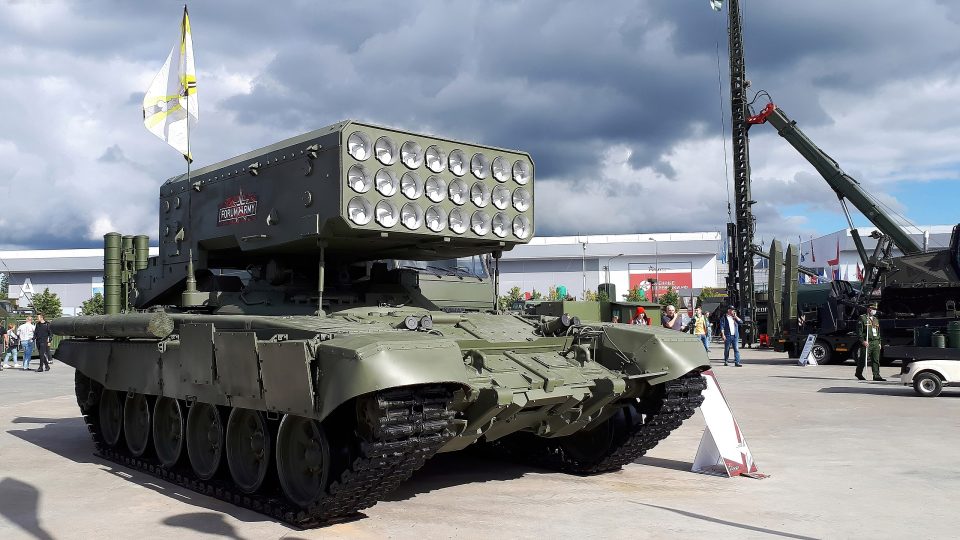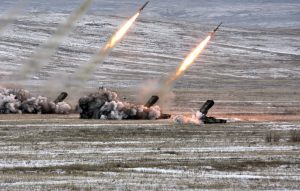
What are thermobaric weapons, and what makes them so deadly?

The Russian invasion of Ukraine seems to be escalating, with the reported use of thermobaric weapons. While the reports are still unconfirmed, Oskana Markarova, Ukraine’s ambassador to the US, recently said Russia is using the weapons, and images and videos posted online seem to show that Russia has deployed the TOS-1 Buratino, a tracked vehicle equipped with 24 rockets with thermobaric warheads. One salvo from a single TOS-1 covers an area measuring 200×300 metres.
Also read: The Federal’s live coverage of the war in Ukraine
Thermobaric munitions – also known as fuel-air explosive devices, or ‘vacuum bombs’ – are not explicitly prohibited for use against military targets.
These devices, which create an oxygen-eating fireball followed by a deadly shockwave, are far more powerful than most other conventional weapons.
Thermobaric weapons are generally deployed as rockets or bombs, and they work by releasing fuel and explosive charges. Different fuels can be used, including toxic powdered metals and organic matter containing oxidant.
The explosive charge disperses a large cloud of fuel, which then ignites in contact with the oxygen in the surrounding air. This creates a high-temperature fireball and a massive shockwave that sucks the air out of any living being in the vicinity.
Thermobaric bombs are devastating and effective in urban areas or open conditions, and can penetrate bunkers and other underground locations, starving the occupants of oxygen. There is very little that can protect humans and other life forms from their blast and incendiary effects.
A 1990 CIA report, cited by Human Rights Watch, noted the effects of a thermobaric explosion in a confined space:
“Those near the ignition point are obliterated. Those at the fringe are likely to suffer many internal, thus invisible injuries, including burst eardrums and crushed inner ear organs, severe concussions, ruptured lungs and internal organs, and possibly blindness.”
The russian army has deployed the TOS-1 heavy flamethrower which shoots thermobaric rockets, the was South of Belgorod. pic.twitter.com/XCxMI3bNB3
— Frederik Pleitgen (@fpleitgenCNN) February 26, 2022
History
Germany developed crude versions of thermobaric weapons during the Second World War. Western states, as well as the Soviet Union and latterly Russia, have used them since the 1960s.
The Soviet Union is believed to have used a thermobaric weapon against China during the Sino-Soviet conflict of 1969, and in Afghanistan as part of its takeover of that country in 1979.
Moscow also used them in Chechnya, and has reportedly provided them to separatist rebels in eastern Ukraine.
The United States has used these weapons in Vietnam and in the mountains of Afghanistan.
The Case Against Thermobaric Weapons
Although thermobaric weapons are not yet unequivocally banned, there are several points that argue against their development and use.
International humanitarian law stipulates what is and is not permissible during warfare. There has long been an understanding that even wars have their limits: while some weapons are considered legal, others are not, precisely because they violate key principles of humanitarian law.
A new report from Human Rights Watch makes it clear the Russian invasion of Ukraine is illegal. It draws on the Geneva Conventions to define the illegitimacy of Moscow’s actions, including its use or potential use of particular weapons.
The use of weapons in indiscriminate attacks – those that cannot distinguish between combatants and civilians – is forbidden by the Geneva Conventions.
A thermobaric weapon might be targeted specifically at military installations and personnel, but its effects cannot be contained to one area. In all likelihood, many civilians would be killed if such bombs were used in any city.
Using explosive weapons in populated areas would result in indiscriminate and disproportionate attacks. Aerial bombs, even if aimed at military objectives, pose a grave threat to civilians because of their wide blast radius.

Unnecessary Suffering
Efforts to ban these weapons have not yet produced a clear prohibition. The 1980 Convention on Certain Conventional Weapons (commonly called the ‘Inhumane Weapons Convention’) addresses incendiary weapons, but states have managed to avoid an explicit ban on thermobaric bombs.
In addition to the impacts on civilians, thermobaric bombs would cause superfluous injury and unnecessary suffering. Under international humanitarian law, they should not be used.
There is a point at which – even if a war is deemed legitimate or ‘just’ – violence must not involve weapons that are excessively cruel or inhumane.
If a weapon is likely to prolong the agony of soldiers (or civilians) or result in superfluous and unacceptable injuries, theoretically its use is not permitted. Thermobaric weapons clearly seem to meet this definition.

